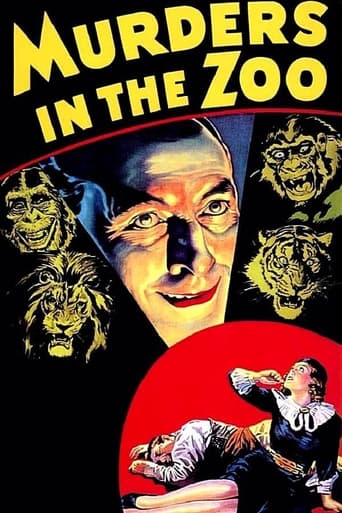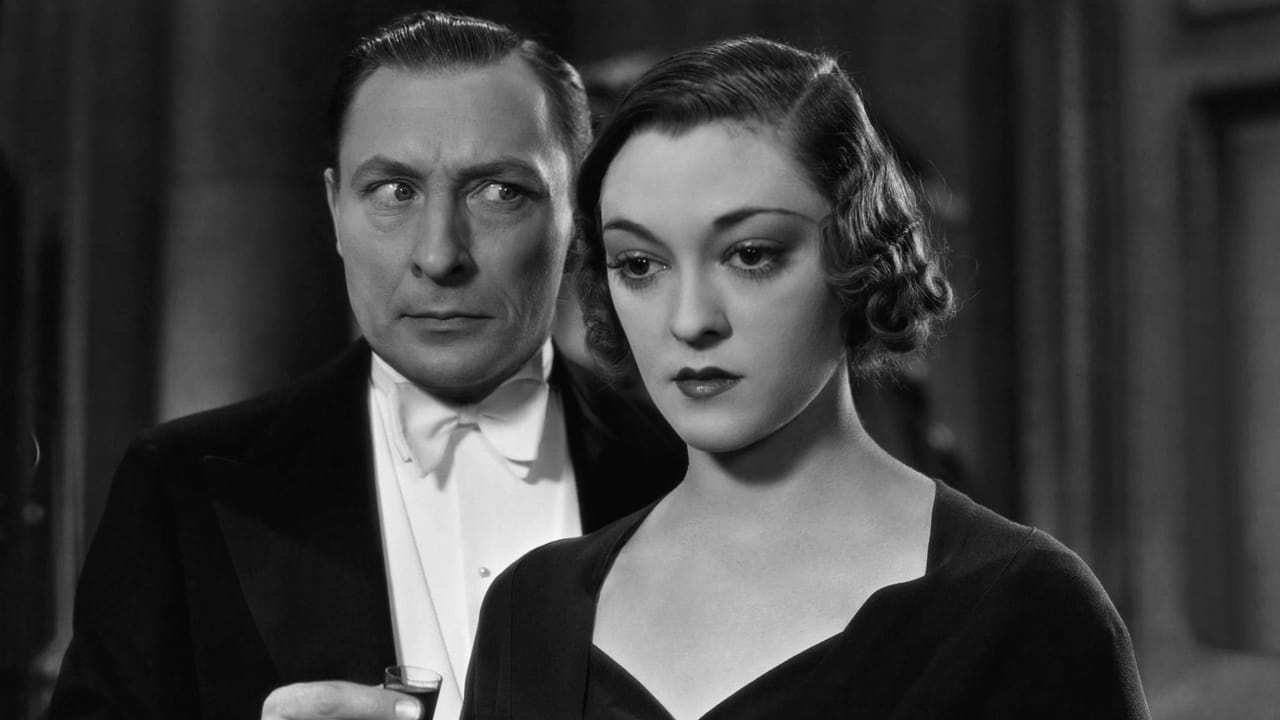JohnHowardReid
Despite the casting of comedian, Charlie Ruggles, as the go-getting lead of Murders in the Zoo (1933), it's actually Randolph Scott who saves the day, but not before villainous Lionel Atwill does his stuff!I must admit I'm a sucker for movies set in a zoo, and this one is no exception despite the fact that we know exactly who the killer is right from the very opening shot. Nonetheless, despite the hard task they set themselves by revealing the killer at this incredibly early stage, screenwriters Seton I. Miller and Philip Wylie do contrive at least two or three quite unexpected twists in the plot. Director Eddie Sutherland is not the most stylish of the Hollywood crop, but he sure knows how keep the story moving along at an agreeable and always interesting level.
marcslope
One of a wave of macabre little "Frankenstein"-inspired horror programmers from the early '30s, this botch has some atmospheric zoo photography (the city is never specified) but is deficient in most other respects. About a mad zoologist who kills anyone who dares to get near his luscious and flirtatious wife, it stars Lionel Atwill, who looks like he's having fun, but whose character makes no sense. Check out one scene where he first professes his undying love for his spouse, then makes sadistic overtures to her, then laughs at her, then kills her. He murders many (and the opening sequence, dispensing with one of her suitors, is quite creepy), in such a way that we can't believe he would ever attain the zoological prestige the script conveys. Young Randolph Scott is another near-casualty, and as his girlfriend, Gail Patrick, so good in later nasty comedic roles, looks bored. Charles Ruggles, as the "comedy relief" publicist, has only two character aspects--he drinks, and he's afraid of animals--and his material falls terribly flat. There are a couple of good animal sequences, including a climax where the evil doctor springs lions and tigers from their cages (and it looks as though animals WERE harmed in the making of this movie), then, in the next sequence, they're safely back, and we're never shown how that happened. The plotting is jumpy, and at 62 minutes, one suspects a lot of continuity was cut.
Hitchcoc
I do enjoy watching Lionel Atwill. Unfortunately, this movie is pretty much without redemption from the asinine murder plot to the humor to the acting to the big lunk, Randolph Scott. Ruggles takes any sort of credibility out of the thing with his silly drunk routine and constant sidetracking. The plot is about a jealous man who kills off anyone who gets the least bit close to his wife. He is big game "bring em back alive" sort of figure. It's one of those films that must have been made to fill a theatre with little kids on a Saturday in the forties. Atwill is really venomous (so to speak), but when he kills his wife (the object of his jealousy) that seems out of character. Zoos must have been quite the attraction in those days. It comes across as pretty exotic.
theowinthrop
I first came across this film in a review in one of William Everson's compendiums of horror film classics. He spoke quite highly of it, but until tonight I never had seen it.MURDERS AT THE ZOO has the plus of Lionel Atwill as a big game hunter named Eric Gorman. He is quite an expert on deadly animals and brings them to the zoo in the city he lives in. But his wife Evelyn (Katherine Burke) has a way of attracting younger, and handsomer men to her attention. Atwill is fiendishly possessive and jealous, and proceeds to kill any man who is having an affair with his wife. But he uses his knowledge of the wild and animals (he later explains he loves animals because of their honesty regarding their feelings, including kill or be killed) to destroy these men. We first see him tying up and leaving a man in the jungle to be destroyed by man-eating tigers. But first he sews the man's lips together so he can't lie or kiss another man's wife (or call for help). A close-up of the man with bloodied, threaded face is briefly shown on camera.On the voyage back home from India Burke meets an American traveler played by John Lodge. Lodge and Burke begin an affair (which Atwill soon is aware of). Atwill pretends he is unaware of it, and invites Lodge to a dinner party (to raise funds for the zoo - this is the depression). At the party Lodge dies, the victim (apparently) of the bite of a green mamba snake that Atwill brought back from India which may have escaped from it's cage. The person that was responsible for the care of the new acquisition is Randolph Scott, here not in his normal western milieu but playing a reptile expert. Scott, with assistant and girl friend Gail Patrick, is struggling to create an anti-toxin for snake venom, particularly those of the deadly Mamba snakes. Atwill jumps to the conclusion that Scott has been criminally negligent regarding watching this deadly snake, and wishes to press charges against him. However, Burke is less willing to believe Scott is responsible, and soon is aware of who is responsible...which is not healthy for her.The use of a deadly snake for killing purposes goes back to Conan Doyle and "The Adventure of the Speckled Band" in the first collection of Sherlock Holmes short stories. But the character I found interesting here is Scott, the reptile man at the zoo. It is hard for us to realize but in the 1930s Americans were still fascinated by the world of zoos and aquariums and the people who searched for or dealt with rare animals. Frank Buck's book BRING 'EM BACK ALIVE described his adventures hunting and trapping dangerous animals (it was a big best seller). The career of Clyde Beatty, as an animal trapper specialist, was followed and led to his career as a circus entrepreneur. But another figure of interest in New York City (which apparently is the city in this film) was Raymond Ditmars, who was in charge of the reptiles in the city zoos and was a recognizable authority on snakes. It is probable that he is the basis for Scott's character (especially in searching for anti-toxins). Atwill gives one of his finest performances here, Gorman's fascination with animals being as important as his sexual insanity (hinted at by his weird, occasional smiling stares and Burke's obvious disgust at him). The acting is competent, particularly Scott and Patrick. There is this problem I find with the fans and opponents of poor Charley Ruggles. Playing an alcoholic reporter trying this last chance job as a publicist, Ruggles is drunk in a couple of scenes (not through the entire film), and has a very funny moment when he finds himself next to the missing green mamba snake - leading to a request for information that could only appear in such a film prior to the real enforcement of the code on movies. He plays a major role in finally bringing Atwill to book at the end. And his last appearance (although drunk) is a curious counterpoint to his Major Applegate in BRINGING UP BABY only four years later.I only have one real problem with this neat little movie - how did Atwill contrive to use his "weapon" without being observed by the people at the dinner? It never is really explained.


 AD
AD




